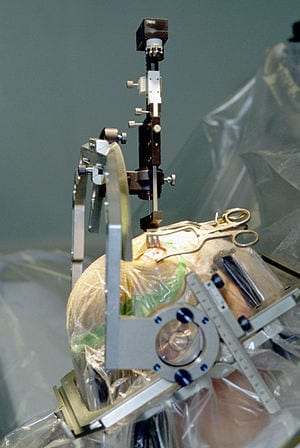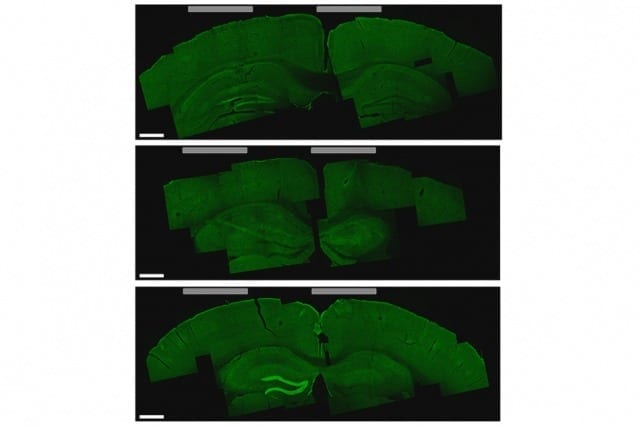
Four of the six patients also experienced simultaneous changes in mood, anxiety, control over emotional responses, urges to binge and purge and other symptoms related to anorexia
In a world first, a team of researchers at the Krembil Neuroscience Centre and the University Health Network have shown that Deep Brain Stimulation (DBS) in patients with chronic, severe and treatment-resistant Anorexia Nervosa (anorexia) helps some patients achieve and maintain improvements in body weight, mood, and anxiety.
The results of this trial, entitled Deep Brain Stimulation of the Subcallosal Cingulate Area for Treatment-Refractory Anorexia Nervosa: A Phase I Pilot Trial, are published today in the medical journal The Lancet.
The study is a collaboration between lead author Dr. Nir Lipsman a neurosurgery resident at the University of Toronto and PhD student at the Krembil Neuroscience Centre; Dr. Andres Lozano, a neurosurgeon, at the Krembil Neuroscience Centre of Toronto Western Hospital and a professor and chairman of neurosurgery at the University of Toronto, whose research lab was instrumental in conducting the DBS research; and Dr. Blake Woodside, medical director of Canada’s largest eating disorders program at Toronto General Hospital and a professor of psychiatry at the University of Toronto.
The phase one safety trial investigated the procedure in six patients who would likely continue with a chronic illness and/or die a premature death because of the severity of their condition. The study’s participants had an average age of 38, and a mean duration of illness of 18 years. In addition to the anorexia, all patients, except one, also suffered from psychiatric conditions such as major depressive disorder and obsessive-compulsive disorder. At the time of the study, all patients currently, or had previously, suffered multiple medical complications related to their anorexia – altogether, the six patients had a history of close to 50 hospitalizations during their illnesses.
Study participants were treated with Deep Brain Stimulation (DBS), a neurosurgical procedure that moderates the activity of dysfunctional brain circuits. Neuroimaging has shown that there are both structural and functional differences between anorexia patients and healthy controls in brain circuits which regulate mood, anxiety, reward and body-perception.
Patients were awake when they underwent the procedure which implanted electrodes into a specific part of the brain involved with emotion, and found to be highly important in disorders such as depression. During the procedure, each electrode contact was stimulated to look for patient response of changes in mood, anxiety or adverse effects. Once implanted, the electrodes were connected to an implanted pulse generator below the right clavicle, much like a heart pacemaker.
Testing of patients was repeated at one, three, and six-month intervals after activation of the pulse generator device. After a nine-month period following surgery, the team observed that three of the six patients had achieved weight gain which was defined as a body-mass index (BMI) significantly greater than ever experienced by the patients. For these patients, this was the longest period of sustained weight gain since the onset of their illness.
Furthermore, four of the six patients also experienced simultaneous changes in mood, anxiety, control over emotional responses, urges to binge and purge and other symptoms related to anorexia, such as obsessions and compulsions. As a result of these changes, two of these patients completed an inpatient eating disorders program for the first time in the course of their illness.
“We are truly ushering in a new of era of understanding of the brain and the role it can play in certain neurological disorders,” says Dr. Lozano. “By pinpointing and correcting the precise circuits in the brain associated with the symptoms of some of these conditions, we are finding additional options to treat these illnesses.”
The Latest Bing News on:
Deep brain stimulation
- Boston Scientific warns on some Vercise Genus implantable pulse generatorson April 25, 2024 at 2:22 pm
Boston Scientific recently issued an urgent field safety notice for certain Vercise Genus DBS implantable pulse generators.
- Brain op failings at trust for more than decadeon April 23, 2024 at 10:19 pm
Failings in a service at an NHS trust that led to probes being located in the wrong part of patients' brains have gone on for more than a decade, the BBC can reveal.
- Brain op failings at trust for more than decadeon April 23, 2024 at 5:00 pm
One University Hospitals Birmingham patient, who underwent deep brain stimulation (DBS), became suicidal after his Parkinson’s symptoms worsened following surgery, but he wasn’t told of the ...
- Parkinson’s disease: Deep brain stimulation offers hope in medication-resistant caseson April 22, 2024 at 5:07 pm
In recent decades, the demographics of people with Parkinson’s disease (PD), which was once thought to primarily affect the elderly, have changed. Do ...
- Medtronic Launches Advanced NeuroSmart Portable MER Navigation System in India for Deep Brain Stimulation Procedure to Manage Parkinson'son April 22, 2024 at 4:14 am
BusinessWire India Mumbai Maharashtra [India] April 22 India Medtronic Private Limited a wholly owned subsidiary of Medtronic plc NYSE MDT today announced the launch of India first NeuroSmartTM Portab ...
- Team demonstrates miniature brain stimulator in humanson April 19, 2024 at 11:14 am
Engineers have developed the smallest implantable brain stimulator demonstrated in a human patient that could revolutionize treatment for drug-resistant depression and other psychiatric or ...
- Deep Brain Simulation Devices Market Size, Share, Key Players, Revenue, Demand, and Forecast 2024 to 2032on April 18, 2024 at 9:42 pm
Report Ocean recently added a research report on “Deep Brain Simulation Devices Market”. The report includes an extensive analysis of the market’s characteristics, COVID-19 ...
- New Study Reveals Unexpected Cognitive Risks in Parkinson’s Treatmenton April 18, 2024 at 5:05 pm
Discovery may reduce possible side effects in Parkinson's disease treatment. A recent study by researchers at the University of Iowa has identified a specific brain region associated with the ability ...
- Girl, 8, benefits from world-first brain surgeryon April 16, 2024 at 10:17 pm
An eight-year-old girl from Cheshire has become the first child in the world to have pioneering brain surgery aimed at easing her dystonic cerebral palsy. Dystonia is a lifelong neurological condition ...
- Scientists Pinpoint Brain Region Crucial for Attention Controlon April 16, 2024 at 2:22 am
Researchers have linked a region in the brain to how humans redirect thoughts and attention when distracted, offering insights into side effects of Parkinson's disease treatment.
The Latest Google Headlines on:
Deep brain stimulation
[google_news title=”” keyword=”deep brain stimulation” num_posts=”10″ blurb_length=”0″ show_thumb=”left”] [/vc_column_text]The Latest Bing News on:
Anorexia Nervosa
- Why Aren't Our Girls and Women Eating?on April 26, 2024 at 5:00 pm
Being a healthy weight is certainly important, but focusing on dieting and restraining food intake does in many cases lead to eating disorders like anorexia nervosa which are extremely resistant to ...
- Tess Holliday Responds to Critic Who Questions Anorexia Diagnosis Just Because She ‘Exists in a Larger Body’on April 25, 2024 at 1:06 pm
Tess Holliday addressed misconceptions about who can be diagnosed with a restrictive eating disorder like anorexia nervosa in a recent video responding to a critic on TikTok.
- 'It takes over': Eating disorder patients struggle to find helpon April 25, 2024 at 5:43 am
Lauren Gaffney developed an eating disorder in her early teens and was diagnosed with anorexia nervosa while in transition year.
- What's New in the Treatment of Anorexia Nervosa and Bulimia?on April 23, 2024 at 5:00 pm
Anorexia nervosa. Unfortunately, the diagnosis of anorexia nervosa is frequently missed because individuals with eating disorders maintain secrecy regarding their symptoms. Eating disorders should ...
- Experimental model elucidates willful starvation in anorexia nervosaon April 22, 2024 at 7:17 am
A new study led by investigators at Beth Israel Deaconess Medical Center (BIDMC) suggests that female mice that are prone to anxiety may prefer and actively seek out a starvation-like state in ...
- I felt ashamed that I had an eating disorder aged 49 when perimenopause started – I’m now happy & healthy thanks to HRTon April 20, 2024 at 3:01 pm
DELICATELY sipping a glass of vegetable juice, Tina McGuff vowed nothing else would pass her lips that day, then she laced up her trainers before starting a vigorous online workout. In the grips ...
- What Triggers Willful Starvation in Anorexia Nervosa?on April 19, 2024 at 1:01 pm
BIDMC research study suggests that mice prone to anxiety may actively seek out a starvation-like state in response to repeated exposure to stress. Learn more.
- Researchers identify 45 distinct brain connectivity alterations linked to anorexia nervosaon April 18, 2024 at 7:00 am
A study using advanced imaging and large sample sizes has unveiled significant differences in brain connectivity patterns between individuals with anorexia nervosa and healthy controls, potentially ...
- Anorexia Nervosa: What to Knowon April 3, 2024 at 5:00 pm
Anorexia nervosa, also called anorexia, is a potentially life-threatening eating disorder that can affect people of all ages, genders, ethnic or racial groups, and body sizes and weights.
- Anorexia nervosa binge-purge type explainedon April 2, 2024 at 4:59 pm
Restricting food intake is one symptom of the binge-purge type of anorexia nervosa. The other main symptom is engaging in binge eating followed by purging through various methods. Anorexia nervosa ...
The Latest Google Headlines on:
Anorexia Nervosa
[google_news title=”” keyword=”Anorexia Nervosa” num_posts=”10″ blurb_length=”0″ show_thumb=”left”]










